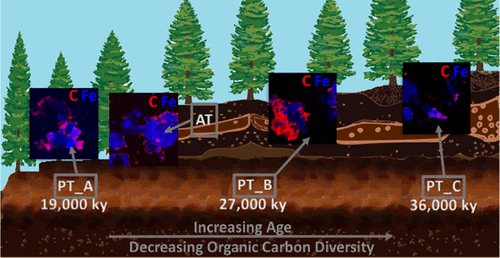当前位置:
X-MOL 学术
›
Environ. Sci. Technol.
›
论文详情
Our official English website, www.x-mol.net, welcomes your
feedback! (Note: you will need to create a separate account there.)
Spatially Resolved Organomineral Interactions across a Permafrost Chronosequence.
Environmental Science & Technology ( IF 10.8 ) Pub Date : 2020-02-14 , DOI: 10.1021/acs.est.9b06558 Tyler D Sowers 1, 2 , Rucha P Wani 1 , Elizabeth K Coward 1 , Matthew H H Fischel 1 , Aaron R Betts 1 , Thomas A Douglas 3 , Owen W Duckworth 4 , Donald L Sparks 1
Environmental Science & Technology ( IF 10.8 ) Pub Date : 2020-02-14 , DOI: 10.1021/acs.est.9b06558 Tyler D Sowers 1, 2 , Rucha P Wani 1 , Elizabeth K Coward 1 , Matthew H H Fischel 1 , Aaron R Betts 1 , Thomas A Douglas 3 , Owen W Duckworth 4 , Donald L Sparks 1
Affiliation

|
Permafrost contains a large (1700 Pg C) terrestrial pool of organic matter (OM) that is susceptible to degradation as global temperatures increase. Of particular importance is syngenetic Yedoma permafrost containing high OM content. Reactive iron phases promote stabilizing interactions between OM and soil minerals and this stabilization may be of increasing importance in permafrost as the thawed surface region ("active layer") deepens. However, there is limited understanding of Fe and other soil mineral phase associations with OM carbon (C) moieties in permafrost soils. To elucidate the elemental associations involved in organomineral complexation within permafrost systems, soil cores spanning a Pleistocene permafrost chronosequence (19,000, 27,000, and 36,000 years old) were collected from an underground tunnel near Fairbanks, Alaska. Subsamples were analyzed via scanning transmission X-ray microscopy-near edge X-ray absorption fine structure spectroscopy at the nano- to microscale. Amino acid-rich moieties decreased in abundance across the chronosequence. Strong correlations between C and Fe with discrete Fe(III) or Fe(II) regions selectively associated with specific OM moieties were observed. Additionally, Ca coassociated with C through potential cation bridging mechanisms. Results indicate Fe(III), Fe(II), and mixed valence phases associated with OM throughout diverse permafrost environments, suggesting that organomineral complexation is crucial to predict C stability as permafrost systems warm.
中文翻译:

永久冻土时间序列上的空间分辨有机体相互作用。
多年冻土含有大量(1700 Pg C)的陆地有机物(OM),随着全球温度的升高,其易于降解。尤为重要的是含有高OM含量的同质Yedoma多年冻土。反应性铁相促进了OM与土壤矿物之间的稳定相互作用,并且随着融化的表层区域(“活性层”)加深,这种稳定作用在永冻土中可能越来越重要。但是,对多年冻土中铁和其他土壤矿物相与OM碳(C)部分的关联的了解有限。为了阐明永久冻土系统中有机矿物络合的元素联系,从阿拉斯加费尔班克斯附近的地下隧道中收集了更新世永久冻土时间序列(分别为19,000、27,000和36,000年)的土壤核心。通过扫描透射X射线显微镜-近边缘X射线吸收精细结构光谱学在纳米到微米级分析子样品。在整个时间序列中,富含氨基酸的部分的丰度下降。观察到C和Fe与选择性与特定OM部分相关的离散Fe(III)或Fe(II)区之间的强相关性。此外,Ca通过潜在的阳离子桥联机制与C缔合。结果表明,在不同的多年冻土环境中,Fe(III),Fe(II)和与OM相关的混合价相,表明有机矿物络合对于预测随着多年冻土系统变暖的C稳定性至关重要。在整个时间序列中,富含氨基酸的部分的丰度下降。观察到C和Fe与选择性与特定OM部分相关的离散Fe(III)或Fe(II)区之间的强相关性。此外,Ca通过潜在的阳离子桥联机制与C缔合。结果表明,在不同的多年冻土环境中,Fe(III),Fe(II)和与OM相关的混合价相,表明有机矿物络合对于预测随着多年冻土系统变暖的C稳定性至关重要。在整个时间序列中,富含氨基酸的部分的丰度下降。观察到C和Fe与选择性与特定OM部分相关的离散Fe(III)或Fe(II)区之间的强相关性。此外,Ca通过潜在的阳离子桥联机制与C缔合。结果表明,在不同的多年冻土环境中,Fe(III),Fe(II)和与OM相关的混合价相,表明有机矿物络合对于预测随着多年冻土系统变暖的C稳定性至关重要。
更新日期:2020-02-17
中文翻译:

永久冻土时间序列上的空间分辨有机体相互作用。
多年冻土含有大量(1700 Pg C)的陆地有机物(OM),随着全球温度的升高,其易于降解。尤为重要的是含有高OM含量的同质Yedoma多年冻土。反应性铁相促进了OM与土壤矿物之间的稳定相互作用,并且随着融化的表层区域(“活性层”)加深,这种稳定作用在永冻土中可能越来越重要。但是,对多年冻土中铁和其他土壤矿物相与OM碳(C)部分的关联的了解有限。为了阐明永久冻土系统中有机矿物络合的元素联系,从阿拉斯加费尔班克斯附近的地下隧道中收集了更新世永久冻土时间序列(分别为19,000、27,000和36,000年)的土壤核心。通过扫描透射X射线显微镜-近边缘X射线吸收精细结构光谱学在纳米到微米级分析子样品。在整个时间序列中,富含氨基酸的部分的丰度下降。观察到C和Fe与选择性与特定OM部分相关的离散Fe(III)或Fe(II)区之间的强相关性。此外,Ca通过潜在的阳离子桥联机制与C缔合。结果表明,在不同的多年冻土环境中,Fe(III),Fe(II)和与OM相关的混合价相,表明有机矿物络合对于预测随着多年冻土系统变暖的C稳定性至关重要。在整个时间序列中,富含氨基酸的部分的丰度下降。观察到C和Fe与选择性与特定OM部分相关的离散Fe(III)或Fe(II)区之间的强相关性。此外,Ca通过潜在的阳离子桥联机制与C缔合。结果表明,在不同的多年冻土环境中,Fe(III),Fe(II)和与OM相关的混合价相,表明有机矿物络合对于预测随着多年冻土系统变暖的C稳定性至关重要。在整个时间序列中,富含氨基酸的部分的丰度下降。观察到C和Fe与选择性与特定OM部分相关的离散Fe(III)或Fe(II)区之间的强相关性。此外,Ca通过潜在的阳离子桥联机制与C缔合。结果表明,在不同的多年冻土环境中,Fe(III),Fe(II)和与OM相关的混合价相,表明有机矿物络合对于预测随着多年冻土系统变暖的C稳定性至关重要。











































 京公网安备 11010802027423号
京公网安备 11010802027423号